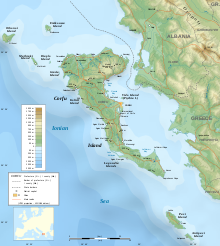Battle of Paxos
| Battle of Paxos | |||||||
|---|---|---|---|---|---|---|---|
| Part of the Illyrian Wars | |||||||
 Map of Corfu and Paxoi on the SE side. |
|||||||
|
|||||||
| Belligerents | |||||||
|
Coalition of Illyrian tribes Acarnania |
Corcyra Achaean League Aetolian League |
||||||
| Commanders and leaders | |||||||
| Demetrius of Pharos | Margos of Keryneia † | ||||||
| Strength | |||||||
| Illyrian fleet 7 Acarnanian ships |
10 Achaean ships | ||||||
The Battle of Paxos was a naval battle between a coalition of Illyrian tribes with their Acarnanian allies, against the allies of Corcyra (modern Corfu), the Achaean League and Aetolian League. The battle took place in the spring of 229 BC and was a direct consequence to the siege of Corcyra by the forces of queen Teuta.
Polybius describes a cunning maritime stratagem mastered by the Illyrian fleet. The Illyrians took four triremes and sank a quinquereme, while the rest of the Greeks managed to escape. This resulted in the Illyrian forces establishing a garrison in Corcyra, under one of the queen’s commanders.
In 231 BC, an Illyrian army, returning north from a raid in the Peloponnese, captured the Epirote city of Phoenice in a surprise attack. After a further defeat in battle, the leaders of the Epirote League lost heart and, although the Illyrian forces were soon recalled to deal with a rebellion in the north following the death of their king, the Epirotes resolved to come to terms with the Barbarians and accept the Ardiaean Kingdom as their new ally against their former protectors from Achaea and Aetolia.
Regent of the Illyrian kingdom became Teuta, the king's widow, who pursued a plan to raid more of the independent Greek colonies on the Adriatic coast; but while she besieged Issa in 230 BC, she made a fatal error when she killed an ambassador of the Roman Republic.
In the spring of 229 BC, queen Teuta fitted out a larger fleet of ships than her previous expeditions and dispatched them to the Greek coasts. Some of them sailed to Corcyra, while another party anchored in the harbour of Epidamnos, professedly to seek water and provision, but really with the design of surprising and seizing the city. After a failed attempt on the city, the Illyrian commanders hastened to get under way and, catching up with the rest of the flotilla, bore down on Corcyra.
...
Wikipedia
